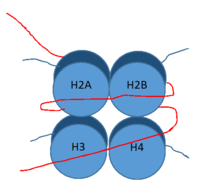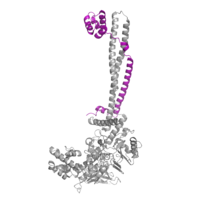User:Nicholas Bantz/Sandbox 1
From Proteopedia
(Difference between revisions)
| Line 10: | Line 10: | ||
=== Tower Domain === | === Tower Domain === | ||
[[Image:COREST.png|200 px|left|thumb|Figure 2: CoRest complex (purple) bound to LSD1 (PDB: 2h94) at the Tower domain.]] | [[Image:COREST.png|200 px|left|thumb|Figure 2: CoRest complex (purple) bound to LSD1 (PDB: 2h94) at the Tower domain.]] | ||
| - | The <scene name='81/811088/Towerdomain/5'>tower domain</scene> is a 100 residue protrusion off of the main protein body of LSD-1, comprised of 2 right-handed [https://en.wikipedia.org/wiki/Alpha_helix-helices 𝛂-helices]. The longer helix, T𝛂A, is an LSD-1 specific element that has not been found in any other oxidase proteins <ref name="Stavropolous">doi: 10.1038/nsmb1113</ref>. The shorter helix, T𝛂B, is positioned near the active site of the oxidase domain. T𝛂B connects directly to helix 𝛂D of the oxidase domain through a highly conserved connector loop. The exact function of the tower domain is not known, but it is proposed to regulate the size of the active site chamber through this <scene name='81/811090/Tb-dinteraction/2'>TαB-αD interaction</scene>. The T𝛂B-𝛂D interaction is responsible for the proper positioning of <scene name='81/811090/Phe538-tyr761interaction/2'>Phe538</scene>, a side chain of 𝛂D that is located in the catalytic chamber, for proper recognition and binding of the substrate lysine through hydrophobic interactions. In addition, the T𝛂B-𝛂D interaction positions 𝛂D in the correct manner to provide [https://en.wikipedia.org/wiki/Hydrogen_bond hydrogen bonding] to <scene name='81/811090/Phe538-tyr761interaction/3'>Tyr761</scene>. Tyr761 is positioned in the catalytic chamber next to the FAD cofactor and aids in the binding of the lysine substrate <ref name="Stavropolous"/>. Therefore, the base of the tower domain forms a direct connection to the oxidase domain and plays a crucial role in the shape and catalytic activity of the active site. In fact, removing the tower domain via a mutation resulted in a drastic decrease in catalytic efficiency <ref name="Stavropolous"/>. The tower domain has also been found to interact with other proteins and complexes, such as CoREST (Figure 2), as a | + | The <scene name='81/811088/Towerdomain/5'>tower domain</scene> is a 100 residue protrusion off of the main protein body of LSD-1, comprised of 2 right-handed [https://en.wikipedia.org/wiki/Alpha_helix-helices 𝛂-helices]. The longer helix, T𝛂A, is an LSD-1 specific element that has not been found in any other oxidase proteins <ref name="Stavropolous">doi: 10.1038/nsmb1113</ref>. The shorter helix, T𝛂B, is positioned near the active site of the oxidase domain. T𝛂B connects directly to helix 𝛂D of the oxidase domain through a highly conserved connector loop. The exact function of the tower domain is not known, but it is proposed to regulate the size of the active site chamber through this <scene name='81/811090/Tb-dinteraction/2'>TαB-αD interaction</scene>. The T𝛂B-𝛂D interaction is responsible for the proper positioning of <scene name='81/811090/Phe538-tyr761interaction/2'>Phe538</scene>, a side chain of 𝛂D that is located in the catalytic chamber, for proper recognition and binding of the substrate lysine through hydrophobic interactions. In addition, the T𝛂B-𝛂D interaction positions 𝛂D in the correct manner to provide [https://en.wikipedia.org/wiki/Hydrogen_bond hydrogen bonding] to <scene name='81/811090/Phe538-tyr761interaction/3'>Tyr761</scene>. Tyr761 is positioned in the catalytic chamber next to the FAD cofactor and aids in the binding of the lysine substrate <ref name="Stavropolous"/>. Therefore, the base of the tower domain forms a direct connection to the oxidase domain and plays a crucial role in the shape and catalytic activity of the active site. In fact, removing the tower domain via a mutation resulted in a drastic decrease in catalytic efficiency <ref name="Stavropolous"/>. The tower domain has also been found to interact with other proteins and complexes, such as CoREST (Figure 2), as a switch to allosterically regulate the catalytic activity of the protein<ref name="Yang">doi: 10.1016/j.molcel.2006.07.012</ref>. Overall, the exact function of the tower domain has not yet been fully determined, but it is known to be vital to the catalytic activity of LSD-1. |
| Line 17: | Line 17: | ||
=== Oxidase Domain === | === Oxidase Domain === | ||
| - | The <scene name='81/811088/Oxidasedomain/4'>oxidase domain</scene> houses the catalytic site of LSD-1. The domain has two distinct regions: one non-covalently binds the FAD cofactor and the other acts in both the binding and recognition of the substrate lysine on a histone tail(H3)<ref name="Stavropolous"/>. The active site cavity is | + | The <scene name='81/811088/Oxidasedomain/4'>oxidase domain</scene> houses the catalytic site of LSD-1. The domain has two distinct regions: one non-covalently binds the FAD cofactor and the other acts in both the binding and recognition of the substrate lysine on a histone tail(H3)<ref name="Stavropolous"/>. The active site cavity is located within the substrate-binding subunit of the oxidase domain and is unique due to its great size. In relation to other oxidases that utilize FAD as a cofactor, LSD-1 has a very large active site cavity that is 15 Å deep and around 25 Å wide <ref name="Stavropolous"/>. In comparison, [https://en.wikipedia.org/wiki/Polyamine_oxidase polyamine oxidase], another FAD-dependent oxidase, has a catalytic chamber roughly 30 Å long but only a few angstroms wide <ref name=”Binda”>PMID:11258887</ref>. The relatively large size of the LSD-1 active site cavity suggests that other residues, in addition to the substrate lysine, enter into the active site during catalysis. These additional residues could participate in substrate recognition and may contribute to the specificity of LSD-1 for H3K4 and H3K9. |
====Active Site and FAD Cofactor==== | ====Active Site and FAD Cofactor==== | ||
| - | Within the active site cavity, there are four | + | Within the active site cavity, there are four <scene name='81/811090/Active_site_pockets/3'>active site pockets</scene> each with differing chemical properties. The catalytic pocket or invagination within the active site (residues Val317, Gly330, Ala331, Met332, Val333, Phe538, Leu659, Asn660, Lys661, Trp695, Ser749, Ser760 and Tyr761) catalyzes the interaction between the FAD cofactor and the substrate lysine <ref name="Stavropolous"/>. This pocket binds and positions the substrate lysine so that it is exposed to the <scene name='81/811089/Fadcofactor/4'>FAD cofactor</scene>. During catalysis, the FAD cofactor is reduced and becomes an anion. Therefore, a positively charged residue is present in most FAD-dependent oxidases to assist in stabilizing the anionic form of FAD. In LSD-1, <scene name='81/811088/Lys661/3'>Lys661</scene> is present in the catalytic pocket of the active site to stabilize the negatively charged FAD <ref name="Stavropolous"/>. The other three <scene name='81/811090/Active_site_pockets/3'>pockets</scene> are not as well understood but predictions can be made about their functions within the active site of LSD-1. Because the active site is able to accept additional residues on the substrate histone other than the lysine, the remaining three pockets are most plausibly responsible for the recognition of chemical modifications on the histone itself <ref name="Stavropolous"/>. The first pocket (Pocket 1) that assists in recognizing chemical modifications on the substrate histone is composed of residues Val334, Thr335, Asn340, Met342, Tyr571, Thr810, Val811 and His812 <ref name="Stavropolous"/>. The second pocket in the active site for side-chain recognition (Pocket 2) is composed of Phe558, Glu559, Phe560, Asn806, Tyr807 and Pro808 <ref name="Stavropolous"/>. Pocket 3 within the active site is composed of Asn540, Leu547, Trp552, Asp553, Gln554, Asp555, Asp556, Ser762, Tyr763, Val764 and Tyr773 <ref name="Stavropolous"/>. Each of the three pockets, in addition to the catalytic pocket, are able to recognize distinct modifications on the substrate and contribute to the specificity of LSD-1. |
Revision as of 18:42, 23 April 2019
LSD-1: Human lysine-specific demethylase 1
| |||||||||||
Student Contributors
- Nicholas Bantz
- Cody Carley
- Michael Thomas




